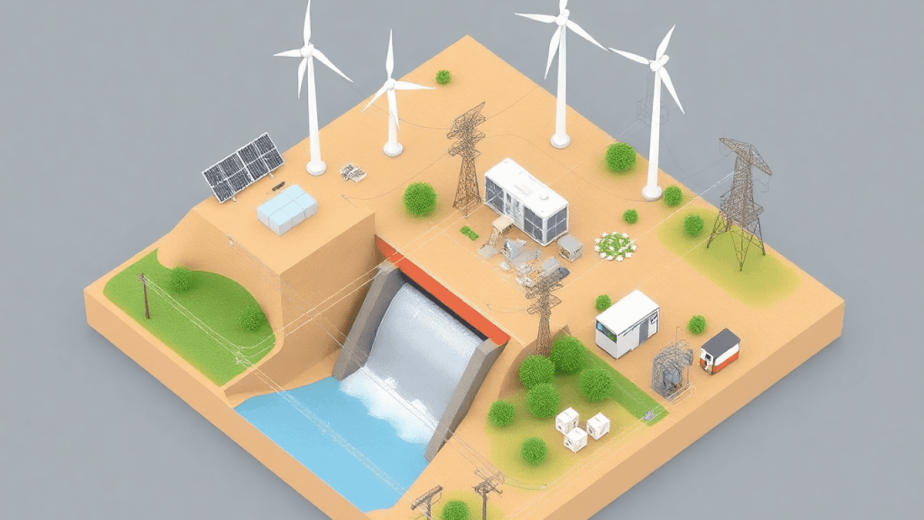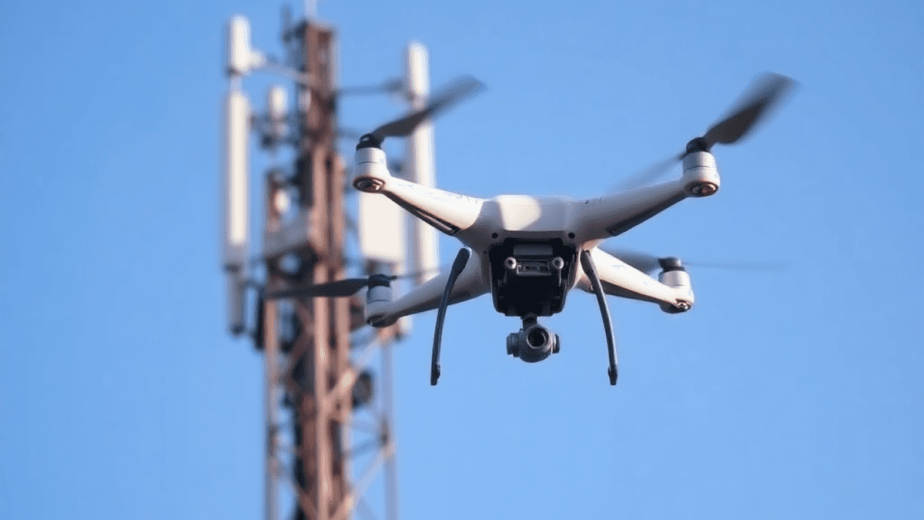Introduction
Inspecting electric utilities is crucial for ensuring reliable service and maintaining infrastructure safety. Regular inspections help identify potential issues before they escalate into significant problems, safeguarding both equipment and communities.
With the advent of drone technology, utility inspections have evolved, offering innovative solutions that enhance traditional methods. Drones provide a unique perspective, allowing for detailed visual assessments without the need for personnel to enter hazardous areas.
This article explores the top benefits of inspecting electric utilities with drones, highlighting their role in improving safety, reducing costs, increasing inspection frequency, and enhancing data collection. By examining various aspects of drone technology in utility inspections, readers will gain valuable insights into its transformative impact on the industry.
1. Safety Improvements
The integration of drone technology in electric utility inspections has led to significant safety enhancements. This innovation addresses several critical factors:
- Elimination of human presence in high-risk areas during inspections reduces the chance of accidents. Drones can access locations that may pose serious threats to personnel, such as high-voltage lines or unstable infrastructures.
- The reduction of accidents related to manual inspections is evident, as drones minimize the need for workers to climb poles or traverse hazardous terrains. This shift not only protects the workforce but also enhances overall operational safety.
Moreover, how drones are reshaping the industry is a testament to their growing importance and effectiveness in various sectors, including electric utilities.
Case studies illustrate these benefits effectively. In one instance, a utility company reported a 50% reduction in inspection-related accidents after adopting drone technology. Such outcomes underscore the transformative role drones play in promoting safer practices within the electric utility sector.
2. Cost Efficiency
Cost efficiency is a significant advantage of using drones for electric utility inspections. When comparing traditional methods to drone inspections, potential savings can range from 30% to 50%. Here are key factors that illustrate this cost-effectiveness:
- Labor Reduction: Drones require fewer personnel on-site, significantly cutting down labor costs associated with manual inspections.
- Reduced Equipment Costs: Traditional inspection methods often involve costly machinery and tools. Drones streamline the process with minimal equipment requirements.
- Lower Insurance Premiums: Fewer accidents during inspections can lead to reduced insurance premiums for utility companies.
The impact of drone technology extends to the overall operational budgets for utility companies. By integrating drones into their operations, utilities can allocate resources more efficiently, enabling enhanced budget management while maintaining safety and productivity levels. Investing in drone technology not only enhances inspection processes but also contributes to long-term financial sustainability.
3. Speed and Frequency of Inspections
Drones offer significant time advantages in the inspection process, operating at speeds of up to 40 MPH. This capability allows for quick coverage of large areas, which is particularly beneficial for electric utilities that require extensive infrastructure assessments.
Key benefits include:
- Rapid Assessments: Drones can complete inspections in a fraction of the time required by traditional methods.
- Increased Inspection Frequency: Regular inspections enhance infrastructure maintenance and reliability. Drones facilitate this by making it easier to schedule frequent checks without committing substantial labor hours.
Utilizing drone technology not only improves inspection speed but also supports the ongoing monitoring necessary to maintain high safety and operational standards within electric utilities. The ability to conduct more frequent inspections leads to proactive maintenance practices, reducing the likelihood of outages and increasing overall efficiency.
4. Comprehensive Data Collection
Drones equipped with advanced sensors significantly enhance data collection capabilities for electric utility inspections. Key technologies include:
- Thermal Mapping: This allows for the detection of heat variations in electrical components, identifying issues like overheating or insulation failures.
- Visual Imaging: High-resolution cameras capture detailed images, enabling the identification of physical damage, vegetation encroachment, and corrosion.
These tools provide critical benefits, such as:
- Increased data accuracy, ensuring that potential problems are spotted early, reducing the risk of failure.
- The ability to create 3D models of infrastructure, offering a comprehensive view for better analysis and understanding.
Enhanced reporting capabilities stem from comprehensive data analysis through drone technology. Utility companies can leverage these insights for proactive maintenance strategies and informed decision-making, leading to improved reliability and safety across their networks.
5. Access to Hard-to-Reach Areas
Drones offer significant advantages when inspecting difficult terrain and remote locations. Traditional inspection methods often struggle in challenging environments like rugged landscapes or mountainous regions. Drones, equipped with advanced navigation systems, can effortlessly maneuver through these areas, ensuring comprehensive coverage without compromising safety or efficiency.
Key benefits include:
- Efficient Navigation: Drones can access hard-to-reach locations where manual inspections may be nearly impossible.
- Minimized Risk: Reducing the need for crew members to traverse hazardous terrains lowers the risk of accidents.
- Improved Data Collection: High-resolution imaging and thermal mapping capabilities allow for detailed assessments of infrastructure in remote areas.
Utilizing drone technology enhances accessibility and streamlines inspection processes, enabling utility companies to maintain infrastructure effectively in even the most challenging environments.
6. Reduction of Human Error and Enhanced Inspection Accuracy with Drones
Drones significantly enhance inspection accuracy through the integration of automation and advanced technology. Key benefits include:
- Minimized Human Error: Traditional inspections often involve subjective errors, influenced by human judgment. Drones eliminate these inconsistencies by relying on precise measurements and consistent data collection methods.
- AI and Analytics Integration: The incorporation of artificial intelligence further refines inspections. AI algorithms analyze vast amounts of data, identifying patterns and anomalies that may go unnoticed during manual inspections. This leads to improved decision-making and risk assessment.
- Consistency in Data Gathering: Automated drone systems provide uniformity in capturing data, ensuring that every inspection adheres to the same standards. This reliability contributes to higher-quality results.
These advancements underscore one of the top benefits of inspecting electric utilities with drones—enhanced inspection accuracy, driving more effective maintenance strategies and operational efficiency for utility companies.
7. Enhanced Emergency Response Capabilities Using Drones
Drones have become invaluable during emergencies, particularly in assessing damage from severe weather events like storms. Their ability to provide rapid situational awareness is crucial for utility companies facing infrastructure challenges. Here are some key benefits:
1. Timely Damage Assessments
Drones can quickly survey large areas, identifying damaged power lines and substations. This efficiency allows teams to understand the extent of the damage without risking human safety.
2. Resource Allocation
With real-time aerial imagery, decision-makers can allocate resources more effectively. Drones deliver accurate data that guides personnel deployment and material distribution where it’s needed most.
3. Immediate Reporting
Advanced drone technology facilitates immediate reporting and communication with emergency response teams, enabling swift action to restore service and ensure public safety.
Incorporating drones into emergency response strategies not only enhances operational efficiency but also significantly improves safety and resource management during critical situations.
8. Environmental Monitoring Benefits Offered by Drone Technology
Drones play a vital role in environmental monitoring, particularly in the context of electric utility operations. Their ability to conduct vegetation monitoring around power lines is essential for preventing hazards such as fires, which can arise from overgrown plants encroaching on electrical infrastructure.
Key benefits include:
- Timely Identifications: Drones can quickly identify vegetation that poses risks, allowing for proactive measures.
- Fire Hazards Prevention: By managing plant growth effectively, utilities can mitigate potential fire hazards, enhancing safety and compliance.
- Ecological Considerations: Regular monitoring supports environmental compliance efforts, ensuring that utilities operate within ecological guidelines while maintaining infrastructure integrity.
This technology not only safeguards utility operations but also contributes positively to ecological balance, reinforcing the importance of integrating drones into environmental management strategies.
Conclusion: Embracing the Future of Electric Utility Inspections with Drones
The future of electric utility inspections is being reshaped by drone technology. The transformative impact is evident in:
- Safety Improvements: Drones reduce human risk in dangerous areas.
- Cost Savings: Significant savings compared to traditional methods.
- Speed and Frequency: Faster inspections allow for more regular assessments.
- Better Data Collection: Advanced analytics improve decision-making.
By adopting drone technology as a valuable tool in managing infrastructure, utility companies can enjoy the top benefits of inspecting electric utilities with drones. Embrace this innovation for safer, more efficient operations.



